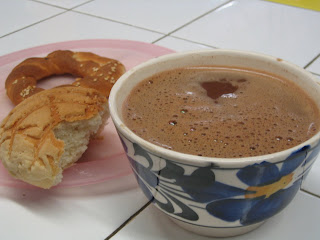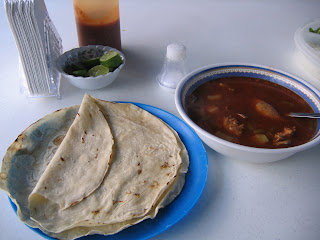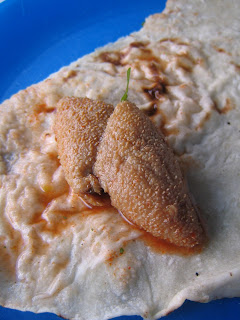
I thought I was going to Ocotlán to check out their Friday market. I didn’t know I was going to find the solace I had been searching for.
The market was sprawling, but with arms radiating out rather than the dense block upon block at Mercado Abastos. Each arm was clearly dedicated to specific items—leather belts or fresh produce or random plastic items. My favorite was the turkey gauntlet, where people formed two long lines while holding their very placid turkeys under their arms. It felt almost stately, like a very dignified beauty pageant. I couldn’t quite tell who was buying and who was displaying, as everyone just stood there with his or her bird(s). I really wanted to take a picture, but I know most people don’t like to have their pictures taken, and I generally don’t ask unless I buy something. This was definitely something I could not take home.
I was there early enough to see the nieve, or sorbet, sellers making their ice cream. They place one bucket inside another bucket of ice and presumably salt, and they just keep turning the inner bucket to churn it to the right consistency. None of it was ready for me to eat, hence, no picture of this either.

But I did feel entitled to take pictures of everything I bought and consumed. I started with a breakfast of enfrijoladas, which are like entomatadas but in bean sauce, rather than tomatoes. It honestly tastes better than you would think. I washed it all down with a nice cup of chocolate con agua, which came with a soft bun with crumbly, sugary top and a hard little pretzel-shaped biscuit. I’ve realized that nearly all the bread in Oaxaca improves vastly when it’s dunked into some hot chocolate. Hot morning drinks, for some reason, always taste better in a bowl than a mug. I think it’s the particularly warm feeling you get when your fingers and palms are wrapped around the smooth curves of a bowl.

I then found a couple of benches full of families eating something I’d never seen before. The women ladled out bowls of dark red soup in the back, while the senora out front chopped at a soft, quivering mass of steamed meat. Chopped hot peppers, onions, cilantro and salsa were on every table, and every few minutes, a woman would walk by offering “blandas,” tortillas that are softer and tastier than their name implies. I wasn’t quite sure what to do, but when I sat down and a blanda seller approached me, a young woman at the next table gave a quick, almost imperceptible smile and nod, so I bought two. It was sort of “build-your-own-picnic,” as her family had also bought some avocados and other garnishes to add to their meal.

The soup turned out to be full of potatoes, carrots, and green beans, as well as several different kinds of unidentifiable organ meat. This thing that looks like a bit of felt is flesh—I know, I ate it.

But even I had my limits. I looked at something that looked like liver, but a tiny bite revealed it definitely was not liver. There was something else that had gelatinous folds, a whole system of mountains and valleys in a bit of meat. I decided not to eat that either.
According to Lety, my Spanish teacher, I ate menudo. Hooray! I’d always wanted to eat menudo.
I bought some albahaca, or basil, since I keep thinking I’m going to make spaghetti with tomato sauce, though it looks and smells distinctly more like Thai basil than sweet basil. I watched several goats go by, bleating wildly. Perhaps they knew something the turkeys didn’t.
My heart never leaps at the thought of touring a church, but I was actually moved when I stopped at the church that had been restored with the help of Rodolfo Morales, the local boy who became a great artist. My pictures don’t capture how fresh and light it looks, or how lovely the ceilings are with their serpentine gilt vines. It was, however, slightly alarming to see mannequins dressed in cheap satin, representing Christ or saints, encased in glass. Catholicism seems sort of blithely unselfconscious about its morbidity.
And then I went to the Casa of the artist himself, which is quite a funny little place. It’s just off the main square in Ocotlan, and when I walked into the arched entryway, there was a young, bearded, artsy-looking guy just sitting on a bench. The gate was closed, but he assured me it was open, and when I approached the gate, a woman appeared with a young boy. They welcomed me in, the woman telling me I could leave my shopping bag on a bench, and the boy wordlessly leading me up the stairs to the second floor with its exhibition hall.
The exhibit showcased the collages Morales had been making near the end of his life, with ribbon, antique images, lace, even faces I recognized as having been cut-out of Benetton ads. The exhibition hall was right next to what used to be his studio, complete with rolls of ribbon.
When I wandered back downstairs, I began to realize what a strange house I was in. He only died in 2001, and you could peer into his bedroom, his kitchen, and his dining room, presumably preserved as he’d left it. On a shelf by the staircase, you could see 30 or so empty perfume bottles, just sitting there like the tchotckes of any older person. But it also became clear that his family was still living in the house day to day.

A senora, older than the woman who’d let me in, was in the gorgeous kitchen when I came in, and she began showing me around, telling me how this horse sculpture made of wood was very old, or how that baby doll in a glass case was very old. The china cabinet was filled with crystal, but it also held a plastic thermos and one antique cup with Japanese faces that the senora had hoped I could identify. As we were talking, we heard a wail come across the courtyard, rising above the birds in their cages. Suddenly, a girl with long curly hair appeared, carrying a smaller little girl who was crying. She stopped crying when she saw me, but she started again after the older girl took her into their bedroom. When I asked where the bathroom was, the senora thought for a bit, and then kindly let me use the family bathroom. As I left, the senora told me that the lady of the house had gone to the market for bread and sodas, so I was very welcome to come back and have a snack with them.
When I left the house, the bearded boy was still there and he asked me what I liked the best. “Oh, the kitchen!” I said.

But before I went back to Oaxaca, I had to eat one last thing: a molote. I hadn’t seen these before, these little torpedo-shaped fried dumplings filled with potato and chorizo. As always, I felt slightly sheepish ordering “un molote,” but the lady was so nice. She asked me with the warmest smile, “Te gusta?”, knowing the answer already. It’s in these moments that I’m glad to be a particularly freaky foreigner—an Asian AND a woman traveling alone. The novelty of seeing me eat and enjoy their food seems to make up for the fact that I can only buy 2 blandas or one molote. When I got back to Oaxaca, I found out from Lety that molotes aren’t easy to find, as they’re usually the kind of food sold in driveways of private houses on Sunday mornings. If only I’d known, I would have bought a bagful.
But perhaps as much as my memories of the food I ate and the art I saw, I think I will treasure the brochure I found at the church for “Neuróticos Anónimos.” According to the brochure, “Neurosis” is “caused by a person’s innate egoism that keeps him from having the ability to love.” It advises the reader to read and answer the quiz in the calmest possible manner, with the most honesty possible. The questions include, among many, “Do you believe the whole world is watching you?” “Do you lie without necessity?” “Do you do things that you consider stupid?” “Do you live disgusted with the entire world?”
So in Ocotlán, I ate several things I’d never eaten before, saw an artist’s home, and learned that I’m not as neurotic as I think I am.
